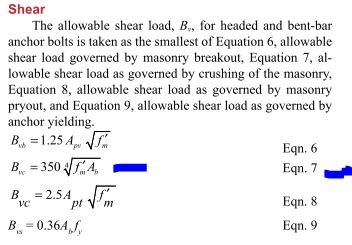hetgen
Structural
- May 3, 2010
- 221
Hi,
Is it okay to use the infill concrete strength instead of f'm ( specified compressive strength of masonry, psi (MPa))in Eqn. 7 when checking the shear capacity of an anchor embedded in concrete masonry as shown in the first picture below?
The clips below are from this document.


Thanks.
Is it okay to use the infill concrete strength instead of f'm ( specified compressive strength of masonry, psi (MPa))in Eqn. 7 when checking the shear capacity of an anchor embedded in concrete masonry as shown in the first picture below?
The clips below are from this document.


Thanks.
